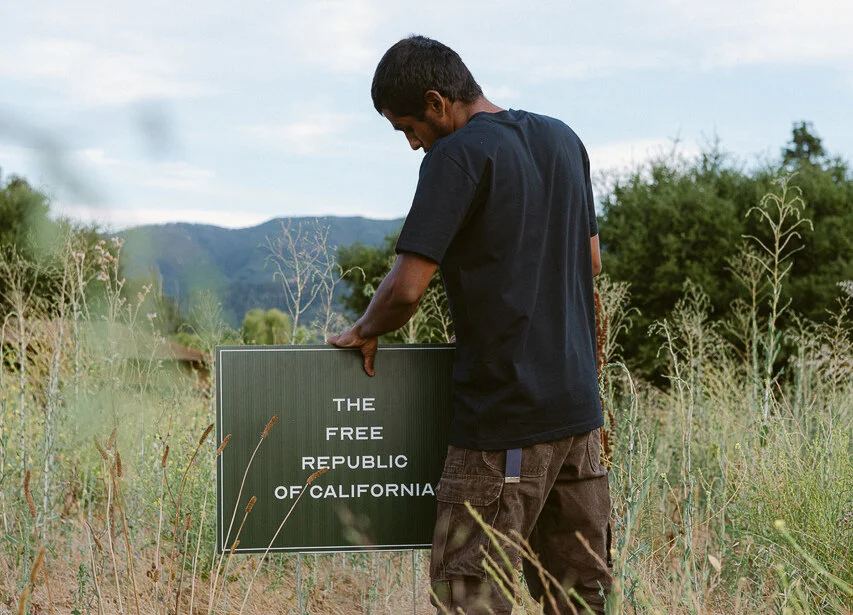Contemporary Craft, Collective Care: Tanya Aguiñiga
By Audrey Lopez
I recently spent a Friday afternoon in Baja California with Los Angeles-based artist, designer and craftsperson Tanya Aguiñiga, sweating under the sun as we set up camp on the edge of the Sea of Cortez. Virtually, that is. I was watching via laptop from the comfort of my front porch as Aguiñiga—from a Covid-improvised studio inside a Volkswagen van parked in her backyard—walked us through a slideshow of her yearly camping sojourn to Bahía Concepción. The first event in the series Travel with Artists, Aguiñiga's online gathering was hosted by Ojai’s Carolyn Glasoe Bailey Foundation as a way to support artists by traveling with them—collectively and virtually—to places that play key roles in their practices.
As Aguiñiga shared memories from over 40 years of travels through Baja with family and friends, I reflected on how her practice shapes and is shaped by constant collective motion, stretching from bodily-based, repetitive gestures of craft and labor to larger-scale patterns of human diaspora and migration. Growing up in Tijuana and crossing the border daily to go to school in San Diego, Aguiñiga explores the personal histories and emotional experiences connected to those movements. She uses craft as a performative medium to generate dialogue around identity, culture and gender while creating community. From felting entire Eames chairs in bright colors to recover a familiar sense of warmth and home, to performing weaving interventions in Beverly Hills using techniques learned from a collective of Maya women weavers in Mexico, Aguiñiga operates at the boundaries of fiber art, design, craft and social practice.
Tanya Aguiñiga, Cosas que Sangran, 2020. Braided cotton rope, cochineal dye, heckled flax.
The artist in Baja.
Engaging with artmaking as an opportunity to create more equitable relationships between people, Aguiñiga aims to decolonize and re-indigenize contemporary approaches to craft, as well as cultivate spaces for marginalized communities within the institutions that exhibit these works. The large-scale hand-woven installations and site-specific fiber sculptures created by her all women/women-identified team at Tanya Aguiñiga Design Studio can be found hanging in contemporary art spaces across Southern California and the US.
Catalyzed through her formative work with the Border Arts Workshop/Tallér de Arte Fronterízo, Aguiñiga's commitment to community-based art and activism underlies her AMBOS Project (Art Made Between Opposite Sides) at the US/Mexico border. Founded by Aguiñiga in 2016, AMBOS is an ongoing series of binational artist interventions and commuter collaborations that seek to express and document border emotion while strengthening community. Ranging from participatory fiber-based installations and youth-made films to interactive sound performances, the works nurture a greater sense of interconnectedness across multiple border cities.
Currently, Aguiñiga is working with AMBOS community partners to help coordinate aid efforts for fifteen migrant/asylum/deportee shelters in Tijuana in need of financial support to provide Covid-related basic supplies. This type of collective care and community through craft is so critically needed at this moment.
Tanya Aguiñiga, Chair for Ray, 2014. Felted raw wool on Eames Wire Chair. Collection of Los Angeles County Museum of Art (LACMA), Gift of Margaret and Joel Chen.
Tanya Aguiñiga, Eames DCM, Found chair (molded plywood, stainless steel), hand-felted Goatland wool.
Tanya Aguiñiga is the 2020 recipient of the Carolyn Glasoe Bailey Foundation Art Prize, awarded annually to a contemporary California artist.
Cover Image: Metabolizing the Border performance, Jan. 14, 2020. Photograph by Gina Clyne. Courtesy of the artist.





